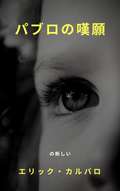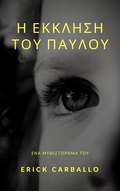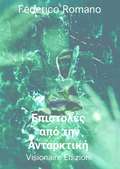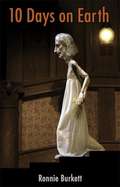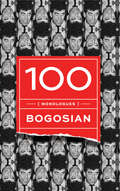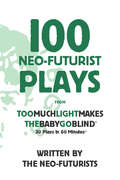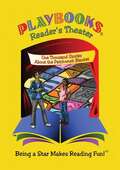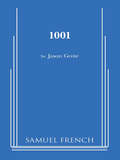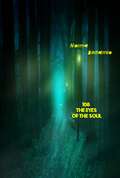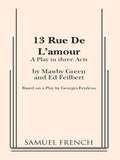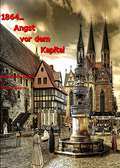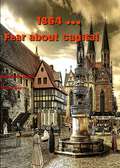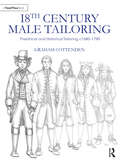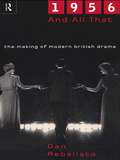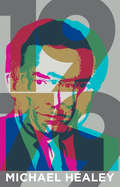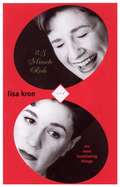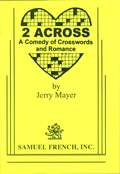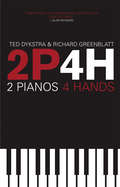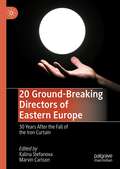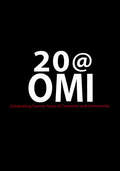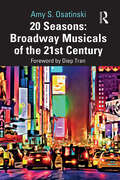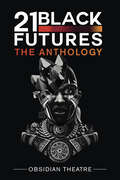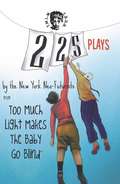- Table View
- List View
パブロの嘆願
by Erick Carballo「ル 命 願 願「 「 パ ブ ロ は 、 信 頼 で き る 友人 が 1 人 し か い な い 8 歳 の 少年 で す が 、 一連 の 出来 事 が 彼 を 悲劇 的 な 運 命 に 導 き ま す。
Συρανό δε Μπερζεράκ
by Edmond RostandThis is the famous 19th-century play about a great swordsman and poet with the unseemly large nose. Although he is feared by opponents, he cannot court the woman of his dreams, except through anonymously sent poems, which makes for a romantic and adventurous tale.
Η έκκληση του Παύλου
by Erick Carballo"Η έκκληση του Παύλου" είναι ένα μυθιστόρημα στο οποίο η μοναξιά, ο εκφοβισμός, η κακία και ο εγωισμός ενός πατέρα είναι αλληλένδετα και η αδιαφορία μιας μητέρας που εγκαταλείπει τον γιο της στη μοίρα του για να ξεκινήσει μια νέα ζωή με άνθρωπος που εξασφαλίζει ένα πολλά υποσχόμενο μέλλον. Ο Πάμπλο είναι ένα οκτάχρονο αγόρι που έχει μόνο έναν φίλο που μπορεί να εμπιστευτεί, αλλά μια σειρά από γεγονότα τον οδηγούν σε ένα τραγικό πεπρωμένο.
Επιστολές από την Ανταρκτική
by Federico RomanoΤο ταξίδι της ζωής ενός αλτρουιστή και γενναιόδωρου άνδρα μέσα από τον πόνο, τη χαρά, τη φιλία, την αγάπη και το θάνατο. Αυτές είναι οι «Επιστολές από την Ανταρκτική», ένα μυθιστόρημα που η πλοκή του διαδραματίζεται σε ένα φανταστικό νησί που είναι περισσότερο ένα μέρος της ανθρώπινης ψυχής. Συγκεκριμένα, η ανθρώπινη ψυχή που συναντάμε εδώ είναι αυτή του Φρέντερικ Τζόνσον. Οι συναντήσεις που θα κάνει, οι σκληρές εμπειρίες της ζωής που θα μπορέσει να αντιμετωπίσει και να χειριστεί, θα ξεδιπλώσουν τη στιγματισμένη ύπαρξη του από τη στιγμή της γέννησης του. Στην πραγματικότητα, νεογέννητος ακόμα, εγκαταλείφθηκε από τη μητέρα του που δεν θα την ξαναδεί ποτέ.
Дон Кихот [Don Kikhot]: A Dramatic Adaptation (Texts and Translations #29)
by Mikhail BulgakovWhen Soviet censors approved Mikhail Bulgakov's ??? ?????, a stage adaptation of Don Quixote, they were unaware that they were sanctioning a subtle but powerful criticism of Stalinist rule. The author, whose novel ?????? ? ????????? would eventually bring him world renown, achieved this sleight of hand through a deft interpretation of Cervantes's knight. Bulgakov's Don Quixote fits comfortably into the nineteenth-century Russian tradition of idealistic, troubled intellectuals, but Quixote's quest becomes an allegory of the artist under the strictures of Stalin's regime. Bulgakov did not live to see the play performed: it went into production in 1940, only months after his death.The volume's introduction provides background for Bulgakov's adaptation and compares Bulgakov with Cervantes and the twentieth-century Russian work with the seventeenth-century Spanish work.
10 Days on Earth
by Ronnie BurkettHe lived alone with very little and more than enough, and preferred it that way. "Simply simply," he was oft heard to say. He was alone, on his own, and that was okay... Darrel is a middle-aged intellectually challenged man who lives with his mother. When she dies in her sleep, Darrel does not realize she is gone, and so, for over a week, he lives alone. Tandem to Darrel's day-to-day routine are the adventures of his favourite children's book characters, Honeydog and Little Burp. Their search for a home leads the dog and duck duo to an understanding of family, while Darrel's ease in the world illustrates just how his mother has paved the path for him to be without her. Episodes from the past, like faded colour snapshots from a family album, illustrate this mother's love for her son in all its honesty and fierce, unwavering will. Simple, tender, funny and unapologetic, 10 Days On Earth asks: If you were alone but didn't know it, would you feel lonely?
100 (monologues)
by Eric BogosianThis new collection by one of America's premier performers and most innovative and provocative artists includes 100 monologues from his acclaimed plays and solo shows including: Drinking in America; Men Inside; Pounding Nails in the Floor with My Forehead; Sex, Drugs, Rock & Roll and more. Also included are additional pieces from Talk Radio and Notes from Underground.
100 Neo-Futurist Plays
by The Neo-FuturistsThis collection of 100 short (very short) plays from The Neo-Futurists' acclaimed cult hit Too Much Light Makes the Baby Go Blind was originally published by Chicago Plays in 1993. The show presents 30 plays in 60 minutes, its ensemble of writer/performers generating between two and 12 new plays each week, as dictated by a roll of the dice. The material runs the gamut of style, tone, and topic: musical, confession, agit-prop, poetic gesture, physical comedy, puppet theater, audience interrogation, folk song, sex joke, and many more. The plays are funny, moving, challenging, powerful, and occasionally just plain weird. There is no fourth wall in Too Much Light Makes the Baby Go Blind - the show embraces the ideal that theater is created in the connection between audience and performer. Randomness, dynamism, speed, brevity, and planned obsolescence are celebrated and exploited to engage and refresh all participants. The plays stand as an entertaining document of the show's output, and they are ideal for scene study, auditions, and competitions.
1000 Stories About the Patchwork Blanket
by Ariana Espiritu Dianna ClevelandA Playbook® Multi-colored and Multi-leveled Role-play Reading Story / Script, A Playbook® Multi-colored and Multi-leveled Role-play Reading Story / Script ,A Playbook® Multi-colored and Multi-leveled Role-play Reading Story / Script
1001
by Jason Grote4m, 2f to play multiple roles / Dramatic Comedy The cuckolded King Shahriyar is marrying a new bride every night and beheading her the next morning. As unrest spreads in the Sultanate, his vizier's daughter Scheherezade hatches a plan: she will offer herself as a bride and seduce the king with stories that leave him hanging on every word. She weaves such tales as "Sindbad the Sailor" and "Alaeddin and His Magic Lamp" with stories of Borges, Flaubert, and Alan and Dahna -- a Jewish man and an Arab woman who have fallen in love in millennial New York City. Shahriyar becomes Alan and Scheherezade becomes Dahna as the worlds mingle and inform one another. Modern speech invades the fantasy tales, and swords and genii appear in the 21st Century, in a dance of cultures and people who are forever intertwined. "[An] explosive, often brilliant work about America, narrative, the Middle East and identity."- Time Out New York "...funny, moving, postmodernist-in-a-good-way... Like Scheherazade's tales, 1001 is endlessly compelling, and also endless (again, in a good way)..."- Boston Globe "Jason Grote is one of a generation of brainy new American dramatists - including Tracy Letts and Will Eno - who understand that to reach new audiences, political theater needs to move beyond moral indignation and outrage, past spoon-feeding an attitude. One key to going forward is looking backward into literature, fable and allegory." - LA Weekly "...a wild and beautiful glimpse at the yarns that shape our lives...Even if it isn't always true, the story we keep telling -- about the power of love, violence, and death -- is a comfort. Grote tackles that concept with gripping imagination, achieving a cosmic scope by eliminating the barriers between worlds." - Variety "Grote's Orientalist fantasia...conjures a storybook world that dissolves, at a moment's notice, into an apocalyptic, 21st-century landscape. Where to begin to describe this seductive if smartalecky, nonlinear play? ...[ 1001] doesn't preach, and it doesn't underestimate the audience's intelligence." - Washington Post
108: How far would you go to catch a dangerous killer?
by Norma Bertalmio108: the eyes of the Soul by Norma Bertalmio How far would you go to catch a dangerous killer? 108: the eyes of the soul A phantom killer commits a series of murders and an impromptu detective tries to chase him ... anywhere and by any means.
13 Rue De L'amour
by Mawby GreenFull Length, Farce/ 5 m, 3 f, extras / 2 ints. Here is the hilarious frolic that launched Feydeau in Paris as the Neil Simon of his day. Take one philandering husband; add his virtuous wife set on revenge, and a doctor determined to be her instrument of revenge; mix well with the husband's friend who is eager to trap his spouse in flagrante delicto and a young nephew with a cocotte to round out his education; toss them together at 13 Rue de L'Amour where a love starved German countess is the concierge; season with a befuddled police inspector and a perky French maid. "The best laid plans for vice and sin go wildly and wonderfully astray."-Seattle Times "Very stuff of comedy whirled around with happy dexterity."-NY Post "Classic farce... thoroughly worth seeing."-NY Times "Indecently funny."-Time ROYALTY FEE: $75 per performance.
1864 ... Angst vor dem Kapital: Eine Mordserie bringt immer eine Reihe von Ermittlungen mit sich ...
by Anna Maria Stratta und Franca Bosco1864 ... Angst vor dem Kapital von Anna Maria Stratta und Franca Bosco Eine Mordserie bringt immer eine Reihe von Ermittlungen mit sich ... 1864 ... Angst vor dem Kapital In einer Wohnung auf der Piazza Vittorio hatte ein junger Aristokrat gerade seiner Geliebten das Leben genommen. Als der Adlige wegging, quälten ihn widersprüchliche Gefühle in ihm, erhoben ihn aber gleichzeitig. Wie schön, Herr über das Leben eines anderen Menschen zu sein. Die Entscheidung, die Existenz einer anderen Person zu beenden, ließ ihn sich fast allmächtig fühlen. Das waren die Gedanken, die ihm durch den Kopf gingen, als ein böses Grinsen seine Lippen spitzte.
1864 ... Fear About Capital: A series of murders always carries with it a series of investigations ...
by Anna Maria Stratta and Franca Bosco1864 ... Fear About Capital by Anna Maria Stratta and Franca Bosco A series of murders always carries with it a series of investigations ... 1864 ... fear of the capital In an apartment in Piazza Vittorio, a young aristocrat had just taken the life of his mistress. As the nobleman walked away, conflicting emotions within him tormented him but at the same time exalted him. How nice to be masters of the life of another human being. Deciding to end the existence of another person made him feel almost omnipotent. These were the thoughts that crowded his head as an evil grin pursed his lips.
18th Century Male Tailoring: Theatrical and Historical Tailoring c1680 – 1790
by Graham Cottenden18th Century Male Tailoring: Theatrical and Historical Tailoring c1680 – 1790 introduces the reader to English eighteenth-century tailoring and covers the drafting of patterns, cutting out in cloth and construction techniques in sequence for the tailoring of waistcoats, breeches and coats. From choosing the right cloth to preparing for the fitting process, this how-to guide will help readers create beautiful, historically accurate eighteenth-century male garments for events and performances. The book contains the following: step-by-step instructions complete with illustrations for students and costumiers who are new to the making of male tailored garments from the eighteenth century; drafting blocks and construction techniques for the different styles through the eighteenth century and patterns, photographs, detailed measurements and articles taken from a variety of male coats, waistcoats and trousers from c1680 – c1790 from museums and collections. 18th Century Male Tailoring is written for costume design and construction students, fashion students and practitioners who have a reasonable working knowledge of sewing and general costume making, but not necessarily of tailoring, drafting patterns, cutting skills and the making of male garments.
1956 and All That: The Making of Modern British Drama
by Dan RebellatoIt is said that British Drama was shockingly lifted out of the doldrums by the 'revolutionary' appearance of John Osborne's Look Back in Anger at the Royal Court in May 1956. But had the theatre been as ephemeral and effeminate as the Angry Young Men claimed? Was the era of Terence Rattigan and 'Binkie' Beaumont as repressed and closeted as it seems? In this bold and fascinating challenge to the received wisdom of the last forty years of theatrical history, Dan Rebellato uncovers a different story altogether. It is one where Britain's declining Empire and increasing panic over the 'problem' of homosexuality played a crucial role in the construction of an enduring myth of the theatre. By going back to primary sources and rigorously questioning all assumptions, Rebellato has rewritten the history of the Making of Modern British Drama.
1979
by Michael HealeyIt’s December 1979 and Clark’s minority Progressive Conservative government is under threat of dissolution before it has a chance to accomplish anything — even pass a budget. But Clark is young and idealistic, resolute on making his mark in office. When he steals a moment at his desk to make a crucial decision, his colleagues, including Brian Mulroney and Pierre Trudeau, take the opportunity to steer him in different directions.
2.5 Minute Ride and 101 Most Humiliating Stories
by Lisa KronThis book collects Lisa Kron's two extraordinary solo performance works. Best known for her ongoing work as a member of The Five Lesbian Brothers, Kron's solo pieces are very personal examinations of both herself and her family history. This is singularly clear in 2.5 Minute Ride, where her writing deftly maneuvers between the tragic drama of the Holocaust and the wry comedy of her family's attempts to pursue pleasure at the local amusement park. This critically acclaimed work played to sold out audience for over six months at New York's Public Theatre. Also included is the riotous 101 Most Humiliating Stories, which first premiered in 1993, and in fact only consists of seventeen tales but each, as the author observes, has several humiliations. It recounts the adventures and misadventures of a self-described Big Lesbian as she tests the boundaries of decorum in social and professional situations.
2 Across
by Jerry MayerComedy / 1m, 1f / Interior Two strangers, a man and a woman (late 40's to middle 50's) board a San Francisco BART train at 4:30 AM. They're alone in the car, each is married, both are doing the New York Times crossword. She's an organized, sensible, psychologist. He's a free spirited, unemployed ad exec. She is a crossword pro, he always quits. When he tosses his puzzle away, she snaps, "Crosswords are a metaphor for life, those who finish, succeed, those who don't, fail." Now he vows to finish. Why? He's a competitor and she happens to be lovely. This starts an 80 minute ride described by critics as "Hilarious," "Witty," "Romantic," "Poignant," "Wonderfully entertaining." Two opposites in an enclosed space, attacking each other's values but also being swayed and intrigued by them. They each have serious life problems that the other helps them solve. Their trip is filled with unpredictable but believable surprises, even a passionate embrace or two. As the train ride ends it's obvious each of them has been changed for the better. And we're dying to know, will these two meet again?
2 Pianos 4 Hands
by Ted Dykstra Richard GreenblattAmidst pushy parents, eccentric teachers, hours of repetitive practice, stage fright, the agony of competitions and exams, and the dream of greatness, Ted and Richard grow up as "piano nerds." As they mature, they become more aware of the gap between the merely very good and the great, and come to the humbling realization that concert stardom may be out of reach, but they just might be two of the best piano players in the neighbourhood, and that in itself is worth celebrating.
20 Ground-Breaking Directors of Eastern Europe: 30 Years After the Fall of the Iron Curtain
by Kalina Stefanova Marvin CarlsonDirectors have long been the main figures on Eastern European stages. During the last three decades some of the most outstanding among them have risen to international stardom thanks to their ground-breaking productions that speak to audiences far beyond local borders. Not by chance, a considerable number of these directors have won the second-biggest theatre award on the continent – the European Prize for (New) Theatrical Realities. It would not be an exaggeration to say that the top directors of the region have been pushing contemporary theatre as a whole ahead into new territories. This book offers informative and in-depth portraits of twenty of these directors, written by leading critics, scholars, and researchers, who shed light on the directors’ signature styles with examples of their emblematic productions and outline the reasons for their impact. In addition, in two chapters the selected directors themselves discuss their artistic family trees as well as the main stakes theatre faces today. The book will be of interest to theatre scholars, students, and anybody engaged with theatre on a global scale.
20@OMI
by Ross Willows Leslie Alan Horvitz Joan KaghanA celebration in words and pictures, 20@OMI offers a vivid portrait of a renowned international, nonprofit arts center in upstate New York. This handsome, lavishly illustrated volume recounts how Art Omi grew from its modest beginnings as an artists' residency program in a converted barn into a thriving arts center boasting four artists residency programs, a sculpture park, a spectacular new visitors' center and year round arts education for local children all located on a beautiful 120-acre campus dedicated to contemporary art and architecture. This is a story which could only be told in the words of the artists, sculptors, writers, musicians, dancers and architects who have participated in Omi's various programs over its first twenty years. The book also features revealing accounts from administrators, program directors, curators, critics and mentors who have worked tirelessly to develop Omi into the vibrant community that it is today. 20@OMI also provides readers with an understanding of the alchemy that happens at Omi. How did Omi become such a crucible of creativity? How has Omi made it possible for artists from all over the world, working in every conceivable medium, to come together in a spirit of collaboration? What happens to artists at Omi that can transform their lives and work so profoundly in just a matter of weeks? For all of the thousands of Omi alumni, 20@OMI is essential reading - the next best thing to actually being there. For those who have yet to experience Art Omi, 20@OMI will serve both as an introduction and as an invitation to come visit.
20 Seasons: Broadway Musicals of the 21st Century
by Amy S. Osatinski20 Seasons: Broadway Musicals of the 21st Century catalogues, categorizes, and analyzes the 269 musicals that opened on Broadway from the 2000-2001 season through the 2019-2020 season. This book is the first to comprehensively examine the musicals that premiered on Broadway during this important historical period, which was bookended by the 9/11 terrorist attacks on one end and the Coronavirus pandemic on the other. It begins by exploring the historical context for the first 20 years of the 21st century and how this impacted American culture and theatre. Rather than chronologically, the musicals are then organized into categories based on their source material and whether they were original musicals or revivals, painting a detailed picture of the Broadway musical in first 20 years of the 21st century. Jukebox musicals, screen-to-stage musicals, revivals, and other original musicals are all covered, and each chapter ends with reading guides and discussion prompts. The book not only discusses what was produced, but by whom, uncovering the stark lack of representation for women and artists of color on Broadway musical creative and design teams. Additionally, the last chapter discusses the COVID-19 pandemic, the Broadway shutdown, and what happened to the Broadway musical during the shutdown, including the response to the Black Lives Matter movement in the summer of 2020. 20 Seasons: Broadway Musicals of the 21st Century will appeal to fans and scholars of musical theatre, as well as students of Musical Theatre, Musical Theatre History, American Studies, and Pop Culture Studies.
21 Black Futures: The Anthology
by Obsidian TheatreWhat is the future of Blackness? Obsidian Theatre presents twenty-one versions of it.In 2021, Obsidian Theatre engaged twenty-one writers to create twenty-one new stories about imagined Black futures. Twenty-one to celebrate Obsidian’s twenty-first anniversary in 2021. Each playwright was tasked with scripting a ten-minute monodrama in response to the question “What is the future of Blackness?” To counter the intense early-pandemic isolation and the trauma of witnessing heightened violence toward Black bodies, Obsidian’s goal was to give as many opportunities to as many diverse Black artists as possible and to bring new voices together from both theatre and film. It was a grand experiment to create a rich tapestry of possibilities and to uplift Black artists in the process.A radical offering in unprecedented times, newly appointed Obsidian artistic director Mumbi Tindyebwa Otu’s curatorial aim was joyful, aspirational, and empowering: come together in this moment and create something communal, unapologetically Black, and with the Black gaze at its centre—art as the architecture for creating those futures. Includes plays by Amanda Parris, Cheryl Foggo, Shauntay Grant, Donna-Michelle St. Bernard, Lawrence Hill, Djanet Sears, and many others.
225 Plays
by The New York Neo-Futurists Joey RizzoloThis book brings together over 200 short (very short) plays from the New York production of the acclaimed cult theater hit "Too Much Light Makes the Baby Go Blind.""Too Much Light Makes the Baby Go Blind," created by Greg Allen, debuted in Chicago in December, 1988, and has been playing to sold out houses ever since. The show presents 30 plays in 60 minutes, 50 weeks a year, to a devoted following. The ensemble of writer-performers generates between two and 12 new plays each week, as dictated by a roll of the dice, creating a constantly changing menu of plays. In 2004, a New York ensemble was formed and the show has been running there since, playing to houses of younger, culturally adventurous audiences as well as seasoned theater-goers. The 225 plays in this volume, culled from more than 1,300 the New York company has generated since 2004, reflect the diversity of 35 current and past ensemble members and the multiplicity of viewpoints and voices they bring to the stage. The material runs the gamut of style, tone, and topic: musical, confession, agit-prop, poetic gesture, physical comedy, puppet theater, audience interrogation, folk song, sex joke, and many more.
